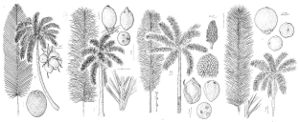Acrocomia
Palm. Fam. 22. 1824, in C. F. P. von Martius et al., Hist. Nat. P.
| Taxon | Illustrator ⠉ | |
|---|---|---|
 | Elaeis guineensis Acrocomia totai Cocos nucifera Syagrus romanzoffiana |
Stems solitary, robust, armed, covered with persistent leaf-bases or bare. Leaves: petioles armed with needlelike prickles; petiole margins unarmed; blade pinnate, armed with prickles; plication reduplicate; segments regularly arranged, apices acute. Inflorescences axillary within crown of leaves, paniculate, arching, becoming pendulous in fruit, with 1 order of branching; prophyll short; peduncular bract woody, prickly, splitting abaxially, curling downward; rachis armed with prickles. Flowers unisexual, sessile, borne in triads of 1 pistillate flower flanked by 2 staminate flowers, staminate flowers borne singly along distal portions of rachillae. Staminate flowers: sepals 3, free; petals 3, valvate, leathery, basally connate, leathery; stamens 6, free; anthers rectangular; pistillode with 3 minute lobes. Pistillate flowers: sepals 3, imbricate, free; petals 3, imbricate, basally connate or nearly free; staminodes well developed, bearing short, sterile anthers; pistils 1, large, tomentose; ovules 3; styles indistinct; stigmas 3. Fruits drupes, globose; exocarp brownish green, thin, pubescent near fruit apex [bristly]; mesocarp fleshy, oily; endocarp thick, bony, with 3 equatorial germination pores. Seeds irregular; endosperm homogeneous; embryo lateral; eophyll undivided [2-cleft], linear-lanceolate. nx = 15.
Distribution
Mexico, West Indies, Central America, and South America
Discussion
Although as many as 30 species of Acrocomia have been described, a recent study (A. Henderson et al. 1995) recognized only two, A. aculeata (Jacquin) Loddiges (including A. totai Martius) and A. hassleri (Barbosa Rodrigues) W. J. Hahn. I maintain A. aculeata and A. totai as two separate species, both of which are cultivated in Florida, where the latter species is naturalized. A general comparison of these two species was made by B. Peterson (1991) in which he noted that the eophyll of A. aculeata is 2-cleft and that of A. totai is undivided. He also found several subtle differences between these species when mature. For example, the trunk spines of A. totai are ca. 12–13 cm and those of A. aculeata are ca. 6–10 cm. Clearly, additional study is warranted to resolve the prickly systematic problems in this genus.
Species 2–30 (1 in the flora).